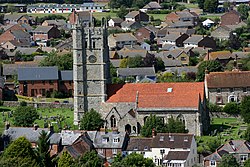Carisbrooke
| Carisbrooke | |
| Hampshire | |
|---|---|
 Carisbrooke Church | |
| Location | |
| Island: | Isle of Wight |
| Grid reference: | SZ483882 |
| Location: | 50°41’30"N, 1°19’2"W |
| Data | |
| Post town: | Newport |
| Postcode: | PO30 |
| Dialling code: | 01983 |
| Local Government | |
| Council: | Isle of Wight |
| Parliamentary constituency: |
Isle of Wight |
Carisbrooke is a village on the south western outskirts of Newport on the Isle of Wight, Hampshire. It is best known as the site of Carisbrooke Castle.
It also has a mediæval St Mary's Church, Carisbrooke. This is said to be the island's finest church. St. Mary's Church, (overlooking Carisbrooke High Street with views to the castle), began life as part of a Benedictine priory, established by French monks about 1150. The priory was dissolved by King Henry V in 1415 during the French Wars. Neglect over the centuries took its toll, but in 1907 the church was restored to its full glory. Its most striking feature is the 14th century tower, rising in five stages with a turret at one corner and a battlemented and pinnacled crown.
There is also a Roman Villa which was discovered in the Victorian era; this is on the site of the old vicarage and has now been converted into private residences.
Carisbrooke is the starting point of the Tennyson Trail, leading to Alum Bay.
History
Carisbrooke is one of the first towns mentioned in the Anglo-Saxon Chronicle, which claims that in 519 a warrior leader named Wihtgar fought the Britons of the Isle of Wight, and that in 530 Cerdic and Cynric, the West Saxon kings, took Wight and slew many men at Wihtgarabyrg.[1] Historians doubt whether this is a genuine place-name origin: the name "Wihtgar" means "Wight-spear", which seem too coincidental and presumably invented later.
Carisbrooke was for centuries the island's capital and was once called Buccombe or Beaucombe, and means the 'fair valley'.
The Governor of Newport once lived at Landscape House, at the upper part of Carisbrooke High Street in the Victorian era.
Alexander Ross, prolific Scottish writer and controversialist, was vicar of Carisbrooke from 1634 until his death in 1654.
The site of the old Carisbrooke railway station lies on the grounds of Christ the King College in the lower part of the field, which is at the end of Purdy Road. The bank is all that remains of the old line.
When in 1917 the British royal family changed its name from the "House of Saxe-Coburg-Gotha" to the "House of Windsor" and renounced all German titles, the title of Marquess of Carisbrooke was created for the erstwhile German Prince Alexander of Battenberg, who also took the anglicised surname "Mountbatten".
Carisbrooke Castle
Carisbrooke Castle was originally a Roman fort. The castle is located at the top of Castle Hill, accessed by Carisbrooke High Street, then bear right at Cedar Hill.It was built soon after William the Conqueror came to England. The William FitzOsbern, 1st Earl of Hereford may have been responsible for its construction, but he was killed in battle during 1071 and so would have had little opportunity to oversee the construction. Osbern's son, Roger, is more likely to have built or refortified the castle. It was at Carisbrooke Castle that William arrested his own half brother, Odo for acts of treason.
King Henry I of England granted the castle in the first year of his reign to Richard de Redvers. The Redvers family owned the castle for much of the Mediæval period, only ending in November 1293 when the last Redvers, Isabel died. In 1136, Baldwin de Redvers took refuge in the castle on the run from King Stephen of England. Unfortunately the wells on the island ran dry and Baldwin gave up the land in exchange for his head. Baldwin's land was restored to him in 1153 when Henry II became king. Baldwin, the last male in the line, died in 1216 poisoned, it is said by Peter II of Savoy. Isabella de Fortibus, Baldwin's sister took control of the castle and successfully ran it until her death in 1293.After the death of Isabella de Fortibus in 1293 the castle became the property of Edward I and the crown.
In 1355 Edward III granted the ownership of the castle to his daughter Isabel. In 1377 The French landed on the Isle of Wight and attacked Carisbrooke Castle. The castle did not fall to the French.
In 1647, Charles I took refuge at Carisbrooke but the castle later turned out to be his prison from where he attempted several times to escape but failed.
Carisbrooke Priory
Carisbrooke Priory is a house offering Christian healing and prayer in an atmosphere of peace and stillness. The Priory is situated on Whitcombe Road, at the junction for Nunnery Lane on top of the hill and is surrounded by beautiful scenery. It is normally open on weekdays from 10:00 am to 4:00 pm (except Bank Holidays) and the first Saturday morning of each month.
Originally built in 1866, known as St. Dominic's Priory it housed Roman Catholic nuns who lived and worked here right up to 1993. The building itself is absolutely stunning, built in a neo-gothic style which was very popular in the Victorian era. Carisbrooke Priory is a local landmark and has excellent views of not only the vast countryside of south wight but also the wall and moat of neighbouring Carisbrooke Castle.
References
- ↑ Anglo-Saxon Chronicle (Parker Chronicle), 519 and 530